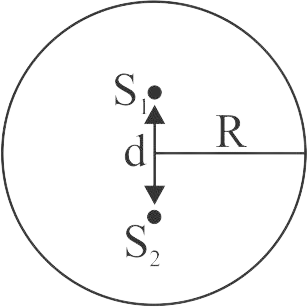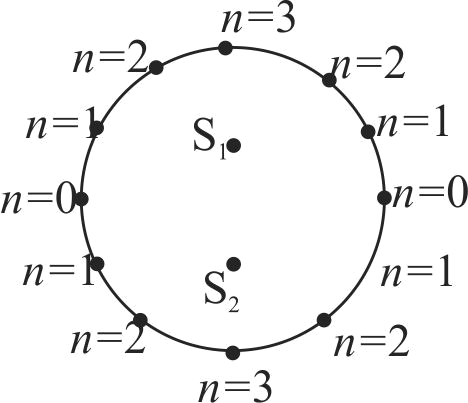367973 Fringes are produced by a Fresnel biprism in the focal plane of an eye-piece which is at a distance of \(1 {~m}\) from the centre slit. A lens inserted between the biprism and eye-piece gives two images of the slit in two positions. In first case, the images of the slit are \(9 \times 10^{-3} {~m}\) and in the second position the images are \(4 \times 10^{-3} {~m}\) apart. If the sodium light \(\left(\lambda=6000 \times 10^{-10} {~m}\right)\) is used, then the distance between the interference fringes is found to be \(1 \times 10^{-{M}} {m}\). What is the value of \(M\)? (Take \(\pi=3.14\) )
367973 Fringes are produced by a Fresnel biprism in the focal plane of an eye-piece which is at a distance of \(1 {~m}\) from the centre slit. A lens inserted between the biprism and eye-piece gives two images of the slit in two positions. In first case, the images of the slit are \(9 \times 10^{-3} {~m}\) and in the second position the images are \(4 \times 10^{-3} {~m}\) apart. If the sodium light \(\left(\lambda=6000 \times 10^{-10} {~m}\right)\) is used, then the distance between the interference fringes is found to be \(1 \times 10^{-{M}} {m}\). What is the value of \(M\)? (Take \(\pi=3.14\) )
367973 Fringes are produced by a Fresnel biprism in the focal plane of an eye-piece which is at a distance of \(1 {~m}\) from the centre slit. A lens inserted between the biprism and eye-piece gives two images of the slit in two positions. In first case, the images of the slit are \(9 \times 10^{-3} {~m}\) and in the second position the images are \(4 \times 10^{-3} {~m}\) apart. If the sodium light \(\left(\lambda=6000 \times 10^{-10} {~m}\right)\) is used, then the distance between the interference fringes is found to be \(1 \times 10^{-{M}} {m}\). What is the value of \(M\)? (Take \(\pi=3.14\) )
367973 Fringes are produced by a Fresnel biprism in the focal plane of an eye-piece which is at a distance of \(1 {~m}\) from the centre slit. A lens inserted between the biprism and eye-piece gives two images of the slit in two positions. In first case, the images of the slit are \(9 \times 10^{-3} {~m}\) and in the second position the images are \(4 \times 10^{-3} {~m}\) apart. If the sodium light \(\left(\lambda=6000 \times 10^{-10} {~m}\right)\) is used, then the distance between the interference fringes is found to be \(1 \times 10^{-{M}} {m}\). What is the value of \(M\)? (Take \(\pi=3.14\) )


